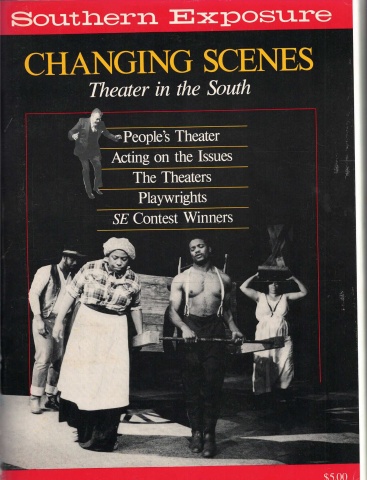Storytelling: The Revival

This article originally appeared in Southern Exposure Vol. 14 No. 3/4, "Changing Scenes: Theater in the South." Find more from that issue here.
The roots of theater, like the roots of literature, history, and even law and religion are in the ancient art of storytelling.
Storytelling is an inner theater. It takes place on the stage of the group imagination, cued by the consciousness of listeners and tellers. It is emergent theater, not yet sprung from the matrix of the community to announce itself as a separable event.
The traditional storyteller blends verbal skill and personal presence to create moments of absorption and release. But, in the South, storytelling is less likely to be recognized as a performance skill like singing, dancing, or playing an instrument than as a personality trait, like cheerfulness, or wit, and as grease for the social wheel. “Old so-and-so can really tell you some tales,” I’ll be told when asking after local tellers. “He’s got a memory like you wouldn’t believe.” Or, “She’s had such an interesting life.”
Some societies, African or Celtic, for example, give the art of storytelling a dignity next to that of statesmanship. Not so in mainstream America; yet the skill is in demand and brings a certain measure of esteem to those it graces.
The rewards of fine talk in a simpler, more rural society were analogous to those of a professional performer in the city: recognition, and social prestige. In turn, the storyteller provided a quickening of the community wit and a celebration of shared experience.
Rapid industrialization and the breakup of traditional communities upset much of the basis for traditional storytelling. Extended oral fictions — the “Jack” tales and animal tales of our root cultures — were the first to go, except in rare isolated families. Thus, the proliferation of technological entertainment threatened to unravel the whole fabric of traditional oral communication, a tradition woven of legendary local history and the leisurely sense of the present.
In the 1970s, storytelling began to spring up again in a revival movement which had its greatest impetus, fittingly enough, in the South. The National Storytelling Festival, founded in Jonesboro, Tennessee as a lighthearted civic promotion in 1973, grew into an international movement. Its organizational arm, the National Association for the Preservation and Perpetuation of Storytelling (NAPPS), now claims over 2,000 members world-wide.
As with other recent cultural revivals, the goals and drives of the storytelling movement are a volatile mixture of the romantic, the antiquarian, the crusading, the pragmatic, the spiritual, and the down-to-earth. NAPPS counts among its members amateurs, professionals, teachers, librarians, folklorists, psychologists, actors, musicians, writers, politicians, preachers, and after-dinner speakers. Is there an authentic “return to the oral tradition” going on, or even possible here? The answer is as complex as the make-up of the revival itself.
The art of many contemporary storytellers is not in any real sense part of the oral tradition. It is not learned by listening and observing life and lore in a living community, nor is it responsively retold. It is scripted, memorized and “done.” These are performing artists who have turned to the products of oral tradition, to folktales collected in print. They may do this for various reasons, not the least of which is that the material adapts itself supremely well to solo performance.
Others who take part in the storytelling revival — particularly those in the South — are deeply rooted, both in their sources and their styles, in local , traditions. Donald Davis of NAPPS
says that there was never, ever, a “storytelling time” at his grandmother’s house. Storytelling was simply what was said in the fields, in the woods, at suppertime and after to pass the time and to brighten and enrich the family’s life.
But the moment the storytelling experience moves from the natural community setting into the auditorium or the festival tent, its dynamics are radically changed. Professional storytelling immediately takes on elements of theater. It is an Event; it starts at 8 o’clock and ends at 10.
One breed of storytelling is not intrinsically “better” than another; both are contributing to the creation of new, cultivated varieties of storytelling. Most of us today have never experienced the ancient tales in their natural, fireside way. But through contemporary performers we can still appreciate the brilliance of their imagery, the simplicity of their forms, and the wisdom woven into their designs.
We love the old tales, too, for the relationships they implied among the tellers, their listeners, and the world. In the constant mutation of oral tales, in the individuality of each performance, in the way the stories’ bones drew flesh and clothing from the countryside around them, the community could help to weave itself whole. This everyday magic is what many modern storytellers have taken into their hearts to perform, and that is why, through the disarray of the contemporary community, some deep study of the workings of tradition is essential.
Tags
Joseph Sobol
Joseph Sobol is a storyteller and visiting artist at Cleveland Technical College in Shelby, North Carolina. (1986)